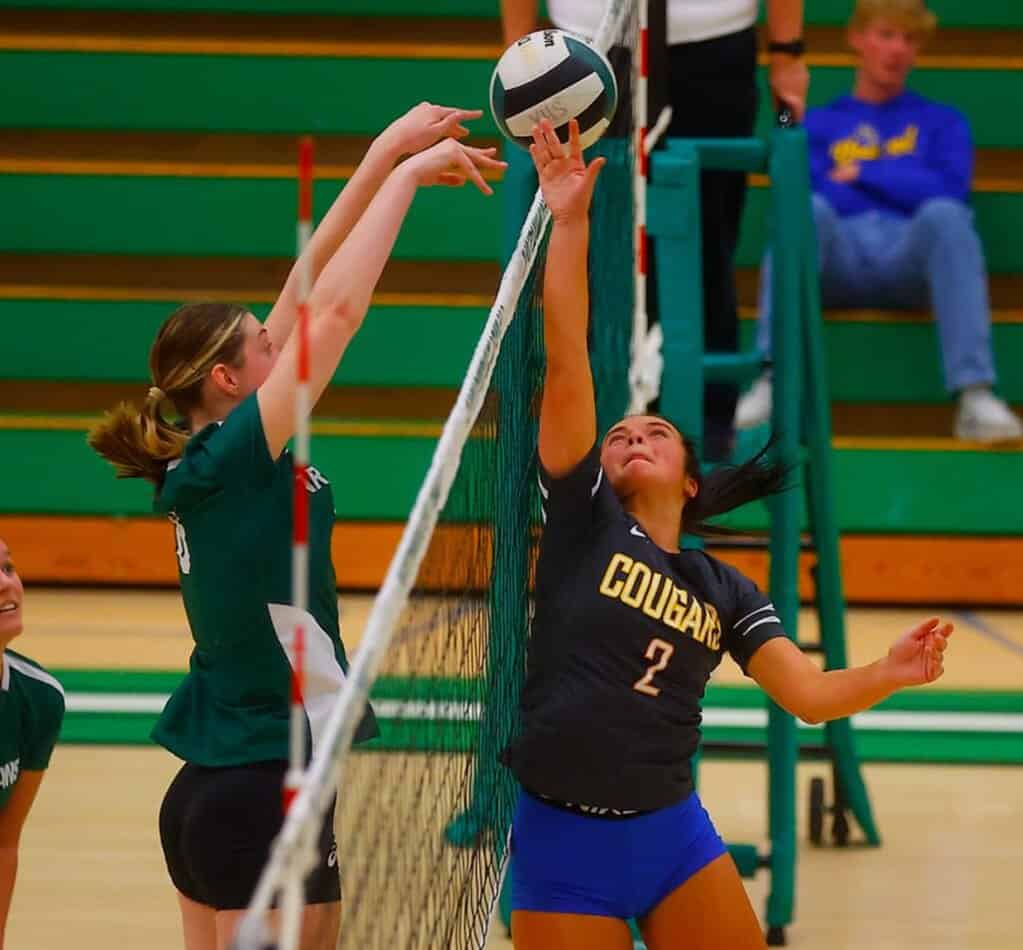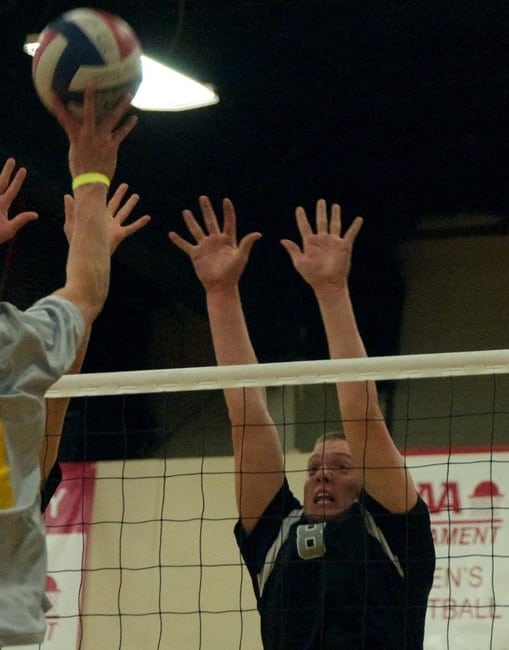Scoring in volleyball isn’t only about having powerful hits but also precise, well-timed shots. Typically, volleyball athletes use hard hits to earn points, but that’s not the only way. Volleyball players can also use attack strategies called the ‘tip’ and the ‘power tip.’
Volleyball power tips are deceptive, forceful tips to score a point at the last minute without spiking the ball. You aim the ball at an exposed spot behind or to the side of the blockers to put the ball out of reach. Tips can result in lift or carry faults so you should learn how and when to use them properly.
Exceptional setting and hitting are crucial to win a volleyball game. However, mastering power tips can take your game to the next level and increase a team’s winning chances. Let’s discuss the importance of volleyball power tips and how they can help players improve their offensive gameplay.
What Exactly Is a “Power Tip”?
A power tip is a tip technique done with force with the goal of scoring a point, usually through deception. At the last second, instead of striking the ball with power, or tipping it softly out of reach, you flick the ball forcefully with your fingertips when an opponent’s defense is off-guard or poorly-timed.

It’s similar to a regular tip (also known as an open hand tip) but with more power to push the ball. Depending on the situation, a good attacker will alternate between a soft tip and a power tip to surprise the defense.
Soft Tips vs. Power Tips
Soft tips or dinks, also known as open hand tips, are a volleyball technique that pushes the ball lightly with the fingertips across the net, and over, or through an opponent team’s blockers. Power tips use the same mechanism but with greater force. By flicking your wrist to fling the ball down, you can direct the ball with speed and force.
Power tips allow volleyball players to have more ball control, but if you’re not careful, they may result in getting called for a lift. A referee will call out a lift if players spend too much time handling the ball.
The best tip for doing legal power tips is to pay attention that when you are pushing the ball, that you’re pushing it forward and down. If you are raising the ball up higher or dragging it horizontally through the air, you’re going to get called.
Keeping your palm facing away from you and flicking your wrist forward and down, usually shows referees that you’re tipping with power, not lifting or carrying the ball.
What Rules Apply to Tipping? (Carry, Lift, etc.)
Dinks and power tips come in handy in volleyball because they can help a team vary their offense and win more rallies when done right. Sometimes power tips are more useful than dinks, depending on the situation. It’s better to power tip when the defense is watching for a soft tip and vice versa.
When a player tips, they usually push the ball with just pressure to get it over the blockers of the other team. The ball often lands somewhere in the center of the court.
Lift and carry are violations in volleyball, which means your opponents will get the point if the referee decides you’ve broken these rules.
Lift and Carry
Lift refers to an action whereby a player lifts the ball in an upward motion in a manner long enough (usually more than 1 second) to be called out by the referee. Players aren’t allowed to lift, so their team will lose the point if they do.
To avoid getting called for a lift, make sure not to contact the ball with the full open palm of your hand. Using fingertips makes it quicker, more like a 1-handed volley. A lift is technically subjective, and it’s entirely up to the referee to decide what’s considered a lift.
Carry is similar to a lift, only that it’s lifted horizontal instead of upwards. If you swipe your hand fast enough you can drag the ball a long way through the air before it falls. Like the lift, a carry is also unacceptable in a volleyball game, resulting in the team losing the point. Also, since a carry is subjective, what’s considered a carry is based on the referee’s judgment.
Double Hit
A double hit is a volleyball violation where the player hits the ball twice in a row. Whether a player hits by accident or on purpose, a double hit is inexcusable and considered a violation and the opponents are awarded the point.
A player may accidentally commit a double hit, especially when they’re unsure if their teammates are ready for the ball. It’s also possible to double hit during a tip. If a player doesn’t tip properly, there’s a chance they will try to tip the ball the second time to make sure the ball crosses the net successfully.
How Can I Use Power Tips To Beat My Opponent?
Most would believe that hitting (or spiking) is the main way to score and win a set, apart from having a strong defense. However, if the ball isn’t set well enough, the player won’t be able to make a full approach and hit the ball. Trying to force every play to end in a hit will end in mistakes, as well as making your offense very predictable.
That is why sometimes it would be best for a player to tip the ball instead of hitting it. Then again, a regular tip is sometimes not suitable for certain situations. When a player finds an opportunity to hit the ball, they can fool their opponents into thinking that the ball will be hit hard, but in reality, the ball is tipped or power tipped instead.

In other words, the attacker has to do something that their opponents don’t expect them to do. Most people expect most points to be scored with powerful hits. That means most defenders would expect hard hits and spikes and expect tips much less often.
Use Power Tips To Save Your Game
Volleyball players should make it a habit to use tips and power tips to vary their playstyle. Players tend to use tips later in the match after the offenses have gotten into a rhythm. Then, when the defenders are watching for your regular tips, surprise them with a power tip, flicking the ball straight to the floor!
Players should practice tips and power tips more often in their practices and gameplay so that when the time finally calls for it, they will always be ready to execute them meticulously.
Next level tipping: A quick-thinking player actually can get another chance to play the ball by aiming the ball at their opposing team blockers’ wrists and forearms so that the ball will either drop between their block and the net or bounce back into your side of the court. When the ball gets back to your side, your teammates can play the ball and set up another attack.
Use Power Tips To Wipe Off the Block
Another way to score is to aim at an opposing team outside the blocker’s external wrist and arms. The reason is to get the rival to return the volleyball to your team’s outside court boundary. This way, your team wins the point.

Use Power Tips To Target Spots
Power tips will play in a player’s favor when they can quickly find an exposed area in the court. If the player cannot find an exposed area to hit the ball, they usually tip behind their opponent’s block.
Practice, Practice, Practice Those Tips!
One of the best ways to tip in volleyball successfully is to aim for the block on purpose. Many players don’t focus on their tip skills as they typically use it as the last option. Knowing when to use a soft tip or power tip can help players improve their volleyball skills and increase their chances of winning the point.
To be good at that, you need a lot of practice. Not only do you want to know when to use either the soft or power tip, but you also want to work on the quality of your power tips. That way, you won’t risk messing it up or have your opponent reading your next move.
Final Thoughts on Tipping
Volleyball power tips are tips with a forward or downward force to aggressively attack without actually spiking the ball. When the ball gets close to the net, the player pushes the ball with their fingertips.
Players have to be careful when using power tips because they don’t always suit certain situations. Sometimes a soft tip/dink is enough to earn the point. By mastering all varieties of offensive attacks, a player increases their chances of winning.
Sources
Photo Credits
Feature image by KLM volleyball flickr.com: https://creativecommons.org/licenses/by/2.0/, cropped to resize.
Yellow wristband tipping image by runnen on flickr.com: https://creativecommons.org/licenses/by/2.0/, cropped to resize.
Air Force vs Navy image by DoD News on flickr.com: https://creativecommons.org/licenses/by/2.0/
Recent Posts
Athletes, listen up! Do you have a closet full of old jerseys, sweatpants, and tees that you just can't seem to part with? Well, dust them off, because you're sitting on a goldmine of fashion...
You may have heard, or you may have noticed, that there's been a change to the rule about double contact in volleyball. In 2022, an experimental rule change began to be implemented, where the double...
